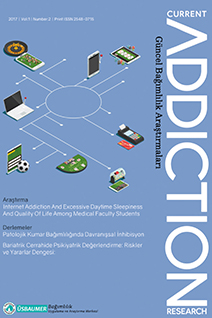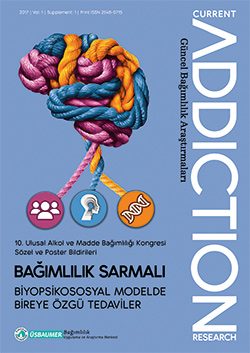Years
2024
Categories
Authors
- Aslı Kayacan (1)
- Cemal Onur NOYAN (1)
- Ceyda ŞİŞMAN ÜNLÜ (1)
- Ceylan Ergül Arslan (2)
- Davut Genç (1)
- Didem Beşikçi Keleş (1)
- Eda Deligöz (1)
- Ekin Sönmez Güngör (1)
- Melike Yerebakan Tüzer (1)
- Merve Metin (1)
- Mine Ergelen (1)
- Murat Yalçın (1)
- Tijen Acar (1)
- Tuba Öcek Baş (1)
- Tuğba Yılmaz (1)
- Zühal Albayrak (1)
- Özge Nur Kutluer (1)
- İrem Teke Bulut (1)
ARTICLES
Original Article
Özge Nur Kutluer,Ceylan Ergül Arslan
2024, 8(1), s:5-12
Objective: In this study, it was planned to investigate the effect of traumatic events experienced by individuals diagnosed with alcohol and substance use disorder on the severity of addiction.
Method: The participants of this study are 50 people who applied to NPİSTANBUL Brain Hospital Amatem service for the treatment of substance use disorder. Of these 50 participants, 47 are men and 3 are women. The research data were collected through the scales given to the survey participants. The Addiction Profile Index (BAPI) was applied to the participants to measure the severity of addiction, and the Traumatic Experiences Scale (TEC) was applied to measure their traumatic experiences.
Results: In the study, the level of significance was taken as 0.05 and 0.001. A moderately significant positive correlation was found between the participants' traumatic experiences scores and their total addiction index scores.
Conclusion: According to the findings obtained in the study, the addiction index diagnosis sub-dimension scores were higher in male participants compared to female participants. It has been shown that childhood traumas impair neural structure and function, making individuals more susceptible to cognitive deficits and psychiatric diseases, including substance abuse (18). Therefore, it is important to evaluate and consider the history of childhood traumatic experiences in relation to substance abuse. The results obtained emphasize the importance of traumatic experiences in addictions to a degree that can contribute to the applications to be developed for addiction treatment and to future research.
Original Article
Mine Ergelen,Didem Beşikçi Keleş,Murat Yalçın,Melike Yerebakan Tüzer,Tuba Öcek Baş,Ekin Sönmez Güngör,Davut Genç,Merve Metin,Aslı Kayacan
2024, 8(1), s:13-19
Objective: Tobacco use, which has been one of the leading causes of preventable death and disability worldwide for many years, increases susceptibility and transmission risk in respiratory infections such as COVID-19, negatively affecting the prognosis. World Health Organization (WHO) recommends quitting smoking or reducing daily consumption, especially during the pandemic, to reduce potential harm. The aim of our study is to present our experience with the application of nicotine replacement therapy (NRT) and the course of psychiatric illness in hospitalized smokers with severe mental illness and COVID-19. Considering the recent pandemic, it is crucial to recommend smoking cessation and provide treatment support to psychiatric patients with severe mental illness accompanied by physical illnesses, infectious diseases, and especially COVID-19 infection, to achieve better outcomes in the treatment of comorbidities and infections.
Method: Our study included 18 smoking patients out of 23 with severe mental illness who were hospitalized in the psychiatric ward and had COVID-19 infection. Records of patients who received NRT were retrospectively reviewed. The severity of nicotine dependence was assessed using the Fagerström Test for Nicotine Dependence (FTND), and agitation was evaluated using the Excited Component Subscale of the Positive and Negative Syndrome Scale (PANSS-EC). PANSS-EC scores at baseline and on day 7 were compared. FTND scores at baseline and on day 30 post-discharge were compared. The correlation between FTND and variables such as the rate of reduction in PANSS-EC and length of hospital stay was investigated.
Results: Two-thirds of the patients had high nicotine dependence with FTND scores ≥ 6. At the end of the first week, an average reduction of 43.1% in PANSS-EC scores was observed. A moderate positive correlation was found between baseline FTND scores and the reduction rate in PANSS-EC scores, and a moderate negative correlation between baseline FTND scores and duration of hospitalization. On the 30th day after discharge, it was found that all patients had resumed smoking, with 44% having FTND scores ≥ 6. A significant decrease was observed when comparing baseline FTND scores with FTND scores on the 30th day post-discharge.
Conclusion: It is important to consider nicotine withdrawal symptoms in patients who smoke and are admitted to a psychiatric unit where tobacco use is restricted, and to consider NRT as part of the inpatient treatment programme. However, according to our results, NRT alone is not sufficient for smoking cessation treatment. It should be supported by motivational interviewing, individual counselling or psychoeducation. In addition, the fact that the patients in our study quit smoking with acute and extrinsic motivation due to COVID-19 infection may be one of the factors that caused them to relapse after discharge. Therefore, comprehensive smoking cessation treatment and NRT for psychiatric patients should be an integral part of inpatient treatment programmes during and after the pandemic.
Review Article
Ceyda ŞİŞMAN ÜNLÜ,Cemal Onur NOYAN
2024, 8(1), s:20-27
Gambling Disorder is a clinical picture characterized by repetitive and persistent gambling behavior. Gambling Disorder is the first and only non-substance-related behavioral addiction in the DSM-5 due to its neurobiological and clinical commonalities with alcohol and substance use disorders. When we examine Gambling Disorder from a neurobiological and neurocognitive perspective, neurotransmitters such as dopamine, serotonin, norepinephrine and glutamate are thought to be effective in the development of the disease. From a neurocognitive perspective, Gambling Disorder is based on behavioral conditioning with positive reinforcers, value attribution, impulsivity and impairments in decision-making processes. If an individual adopts gambling behavior as a coping mechanism for negative life events, this behavior continues to increase over time. Increasing gambling behavior over time weakens the individual's self-control capacity and leads to the continuation of gambling behavior despite the negative consequences. This vicious cycle contributes to the exacerbation of the disorder by causing problems in work, family, academic and social areas. Gambling Disorder, although initially a seemingly harmless behavior, can turn into addiction depending on the balance of underlying predisposing and protective factors.
Review Article
Psychology-Related Factors Of Internet Addiction: Literature Review
Eda Deligöz
2024, 8(1), s:28-33
Original Article
İrem Teke Bulut,Ceylan Ergül Arslan
2024, 8(1), s:34-44
Objective: In this study, it was aimed to Decipher the relationship between the emotion regulation difficulty levels and psychological well-being levels of individuals who use tobacco.
Method: The study group of this study was composed of people between the ages of 18-65 Dec. The research data were collected by reaching 212 people virtually through a survey. The data were sent to the participants online with the ‘Sociodemographic Information Form’ prepared by the researcher, the ‘Emotion Regulation Difficulty Scale’ (DERS) and the ‘Psychological Well-Being Scale’ (PWB) scales and they were asked to answer and the answers were evaluated and collected.
Results: Within the scope of the study, the data of 212 participants who smoked were examined. The sociodemographic variables of the participants were compared with their emotion regulation difficulties and psychological well-being levels. In addition, the relationship between emotion regulation difficulties and psychological well-being levels of smokers was examined. According to the findings obtained in the study, significant differences were found in the scores of psychological well-being and difficulties in emotion regulation in terms of gender, marital status, employment status, income level, psychological disorder, presence of a smoker in the family, reason for smoking.
Conclusion: In addition, a negative, moderate and significant relationship was found between psychological well-being and difficulty in regulating emotion in smokers. The total score of emotion regulation difficulty predicts psychological well-being scores negatively and significantly. The model explains the variance by 14%. According to the findings regarding the prediction of psychological well-being scores by sub-dimensions of emotion regulation difficulties, it was found that difficulty scores in developing emotion regulation strategies predicted psychological well-being scores negatively and significantly. The model explains the variance at a rate of 16%.
Original Article
The Turkish Adaptation, Validity And Reliability Study Of The Beliefs About Thirdhand Smoke Scale
Tuğba Yılmaz,Zühal Albayrak,Tijen Acar
2024, 8(1), s:45-51
Objective: Thirdhand smoke is an important public health problem. The aim of this study is to adapt the ‘‘Beliefs About ThirdHand Smoke’’ scale developed by Haardorfer et al to Turkish, to examine its validity and reliability.
Method: This methodological study was conducted in Ankara between 01.05-29.6.2021. Turkish version of the original scale “Beliefs About ThirdHand Smoke Scale’’ was obtained firstly. For the scale validity and reliability analyzes were performed: For content validity expert views were received, for construct validity confirmatory factor analysis; for reliability internal consistency, intra-class correlation were performed. Voluntary 256 adults who applied to polyclinics of Kecioren Training and Research Hospital, spoke Turkish, communicated, smoked or living at least one person who smoked, “socyodemographic features form” and Turkish version of the original scale “Beliefs About Third Hand Smoke Scale’’ was applied face to face. The data analysis used IBM SPSS 24.0 and AMOS 21.
Results: Turkish adaptation of the original scale “Beliefs About Third Hand Smoke Scale’’ is 9 items, 2 factors. The content validity index for all items Turkish version of the original scale “Beliefs About Thirdhand Smoke Scale’’ is ≥0.80; there is inter-expert fit. Cronbach's alpha values overall/factors are 0.910/0.849, 0.835 respectively; scale is high reliable, factors are acceptably reliable. Item-total correlation is 0.580-0.794; each item is acceptably distinctive, should remain at scale. Intra-class correlation, inter-items correlation matrix r values are 0.376-0.771; items are related intermediately, internally consistent. Confirmatory factor analysis goodness-of-fit values, CMIN/df=3,1, RMSEA=0,091, RMR=0,054, GFI=0,946, AGFI=0,889, NFI=0,953, CFI=0,967; two-factor structure of the scale well-fitting to the data was confirmed.
Conclusion: Turkish adaptation of the original scale developed by Haardorfer et al in 2017 “Beliefs About Thirdhand Smoke Scale’’ is a reliable and valid measurement tool.
Turkish version of the original scale “Beliefs About Thirdhand Smoke Scale’’ can applied in studies and trainings, increase awareness of the thirdhand smoke and guide the fight against tobacco.



 2. Sayı
2. Sayı
 1. Sayı
1. Sayı
 Ek Sayı
Ek Sayı







